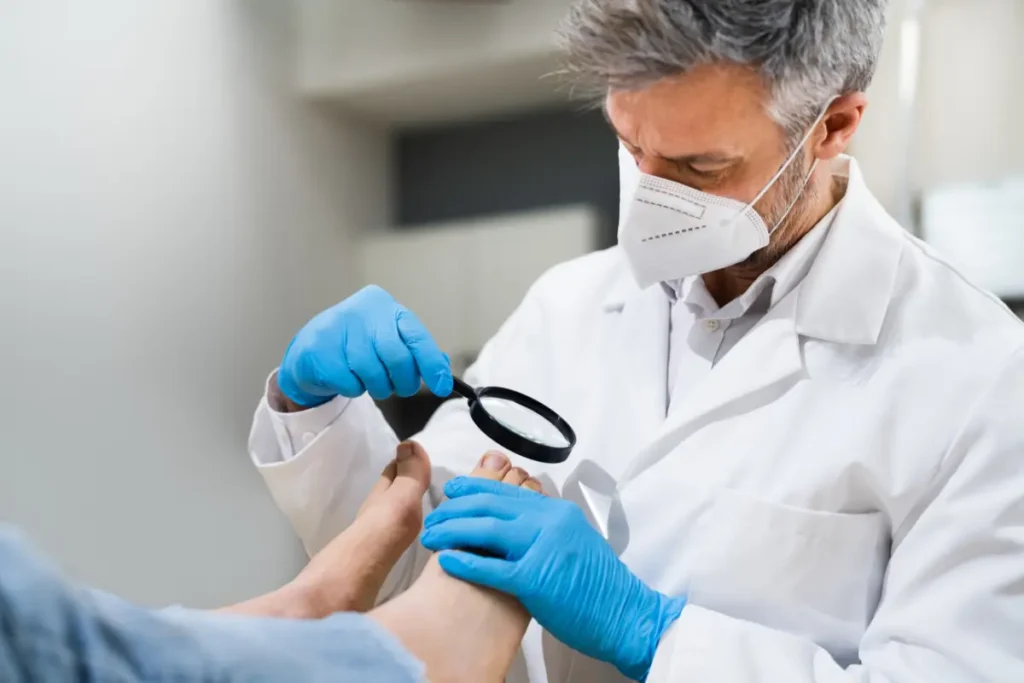This guide is for informational purposes only. Some services may not be offered in our offices. Your doctor will guide you through your treatment options during your appointment.
Recovering from toenail removal can be a daunting experience, but with the right aftercare, you can facilitate a smooth and speedy recovery. This comprehensive guide is designed to equip you with essential knowledge and practical steps to navigate the healing process effectively.
We will cover the reasons for toenail removal, the post-surgery care essentials—including dressing changes, foot soaks, and pain management techniques—guidelines for appropriate footwear and activity modifications, and tips for preventing future toenail problems. By following this guide, you can ensure optimal healing and get back to your daily activities with confidence.
Reasons for Toenail Removal
Toenail removal is often necessary due to issues like painful ingrown toenails or severe infections. Surgical options include Wedge Resection, Toenail Removal, and Matrixectomy, depending on the severity of the condition. Common causes of ingrown toenails are trimming nails too short, wearing tight shoes, and sustaining trauma.
Surgical Procedure Overview
A qualified podiatrist performs toenail removal surgery using local anesthesia. The procedure generally involves:
Numbing the toe
Cutting away the ingrown portion of the nail
Possibly removing the entire nail
In some cases, medications may be used to inhibit nail regrowth. Understanding the reasons for your surgery and the procedure can help you make informed decisions about your aftercare.
Dressing the Wound
After toenail removal, keeping the wound clean is crucial. Here are the steps to follow:
Clean the Area: Use warm, soapy water to gently cleanse the toe, then pat it dry.
Change the Dressing: Soak your foot in warm water to ease dressing removal, then change the dressing once or twice daily or as directed by your healthcare provider.
Keep it Covered: Maintain a dry dressing for the first week. You may leave it uncovered at night during the second week to promote airflow.
Foot Soaks and Epsom Salts
Soaking your foot in Epsom salt can provide numerous benefits, including pain relief and inflammation reduction. For optimal results:
Frequency: Soak 2 to 3 times daily as your toenail begins to regrow.
Post-Soak Care: After soaking, dry your foot thoroughly, apply antibiotic ointment, and redress the wound.
Pain Management Techniques
Managing post-surgery pain is vital for a comfortable recovery. Consider these strategies:
Over-the-Counter Pain Relievers: Medications like Tylenol, Motrin, or Ibuprofen can be effective.
Warm Water Soaks: Soaking your foot can alleviate soreness.
Icing: Apply ice to the area within the first 24 hours to reduce swelling and discomfort.
Choosing the Right Footwear
Selecting suitable shoes significantly impacts your recovery. Follow these recommendations:
Initial Footwear: Wear open-toed or loose shoes for at least two weeks.
Avoid Tight Shoes: Choose sandals or soft shoes with ample room for your toes to heal.
Return to Normal Activities: Generally, you can resume regular activities within a few days but avoid strenuous activities until cleared by your podiatrist.
Monitoring for Signs of Infection
Being vigilant about signs of infection is essential. Contact your healthcare provider if you notice:
Increased redness, swelling, or pain after a few days
Pus or discharge from the wound
Fever or chills

Practicing Good Nail Care
To avoid future toenail problems, implement the following nail care practices:
Cut Straight Across: Avoid cutting nails too short or curving the edges.
Footwear Choices: Steer clear of tight, pointy shoes, and replace footwear every 8 to 12 months.
Moisturize: Keep your feet hydrated and avoid cutting the cuticles.
Importance of Follow-Up Care
Schedule a follow-up visit with your podiatrist after toenail removal. During this appointment, your podiatrist can:
Assess the healing process
Check for signs of infection
Provide further treatment recommendations
The information on our website is intended for general informational and educational purposes only and should not be used as a substitute for professional medical advice. For any health-related concerns, we strongly recommend consulting with a healthcare professional. Please note that any reliance on the information found on our site is solely at your own risk. For more details, please see our Medical Disclaimer.
Modern Foot & Ankle offers expert foot and ankle care, conveniently located in your Florida or Texas community. Our multiple locations offer a wide network of the best podiatrists, skillfully trained to meet your specific needs. Our nationally recognized physicians and surgeons cover the full spectrum of foot and ankle concerns, including complex lower extremity conditions. Our foot and ankle doctors combine advanced technology with patient-centric care to deliver treatment plans to get you back on your feet, often right inside your neighborhood.
Browse our extensive network of offices across Florida and Texas, and experience the best foot and ankle care at your nearest local Modern Foot & Ankle location.
Stay informed by reviewing some of our patients frequently asked questions about what to expect when visiting one of our Florida or Texas foot and ankle care offices. Contact the office directly if you need further assistance. We’re here to help!
Modern Foot & Ankle offers a wide range of podiatry services including foot and ankle surgery, sports medicine, pediatric foot care, wound care, orthotics, and more. They also provide specialized treatments for conditions such as bunions, hammertoes, heel pain, and ingrown toenails among others.
To schedule an appointment, you can call the clinic directly or fill out the appointment request form available on their website. They have multiple locations, so you can choose the one that’s most convenient for you.
During your first visit, the podiatrist will conduct a thorough examination, discuss your medical history, and address any concerns or symptoms you may have. They will then develop a personalized treatment plan based on your specific needs.
Yes, the podiatrists at Modern Foot & Ankle are skilled in performing a variety of foot and ankle surgeries. These include procedures for bunions, hammertoes, fractures, and more. They utilize the latest techniques and technology to ensure the best possible outcomes for their patients.
Modern Foot & Ankle is committed to providing comprehensive, high-quality podiatric care. They believe in a patient-centered approach, where the focus is on educating patients about their condition and treatment options, enabling them to make informed decisions about their care.
Modern Foot & Ankle accepts a variety of insurance plans. It’s recommended to check with the clinic directly or with your insurance provider to confirm coverage before scheduling an appointment.

